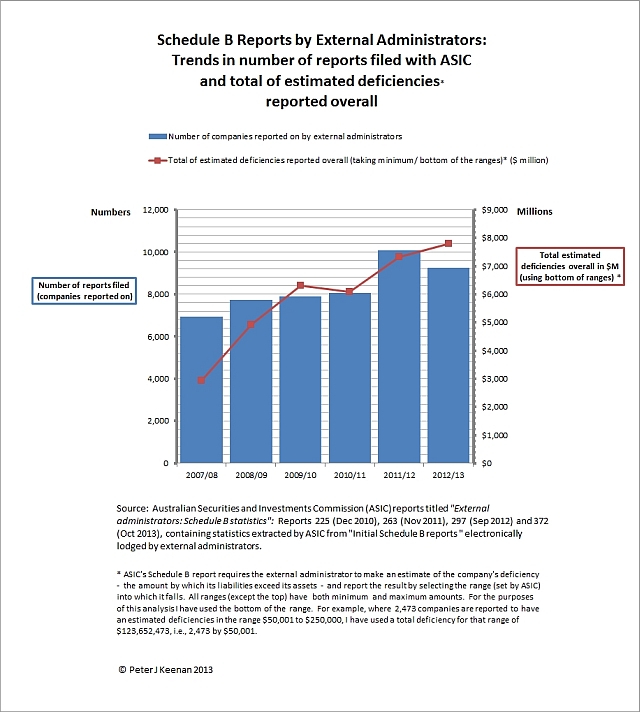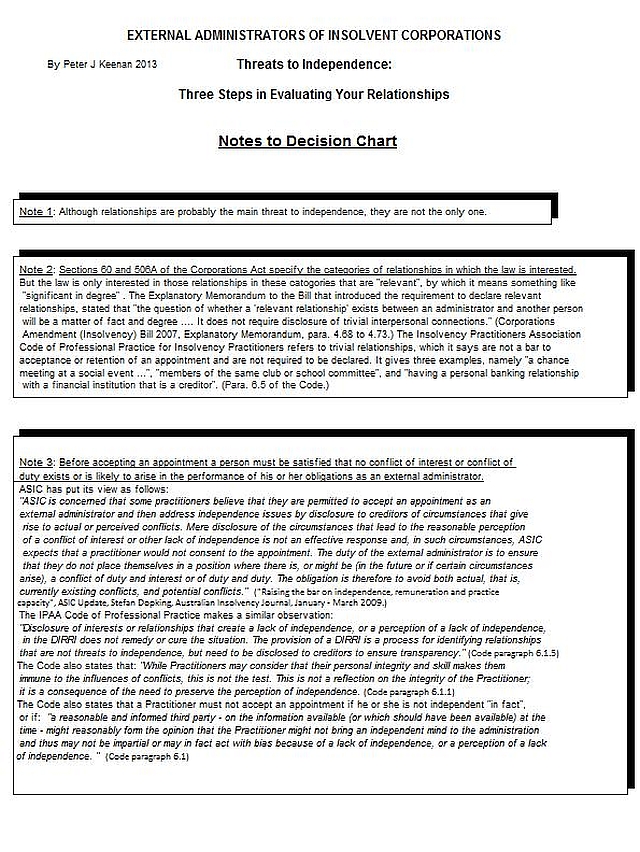When the Australian Securities and Investments Commission (ASIC) released its report on supervision of registered liquidators it bemoaned the fact that its compliance checks had found a 10% increase in inadequate declarations, up from 46.9% in 2011 to 56.3% in 2012.
In the accompanying Media Release ASIC Commissioner John Price was fairly blunt:
“The increase in inadequate declarations concerns ASIC. Liquidators must make full disclosure to creditors when it comes to their independence. Given our guidance, and education programs through the Insolvency Practitioners Association of Australia (IPA), there is no good reason for such a failure rate.”
Under the Corporations Act 2001 liquidators and administrators (other than those appointed by the Court) are required to make written declarations to creditors concerning indemnities they have received and relationships they have, or have had, with certain defined “persons” within the preceding 24 months. Both declarations are to be made and sent to creditors before the first meeting of creditors is held. The Declaration of Relevant Relationships and Declaration of Indemnities are referred to collectively in the insolvency profession as a DIRRI.

An “inadequate” DIRRI is described in ASIC’s report (para 56) as one which:
(a) fails to disclose a relevant relationship in pre-appointment dealings and/or, where such a relevant relationship has been identified, adequately explain why it does not create a conflict of interest;
(b) fails to disclose all companies involved in appointments to a group of companies, and whether or not circumstances existed between the group entities that may give rise to a conflict and, if so, how the appointees would manage those issues; and/or
(c) is not signed by all appointees.
More detailed guidance on how to make sure a DIRRI is adequate was given to registered liquidators in an email sent to them on 28 June 2013 by Adrian Brown, leader of ASIC’s Insolvency Practitioners Team.
The email extract below is Mr Brown’s description of “seven key areas for improving the likelihood that your DIRRIs do comply with the law, relevant professional standards and the IPA’s Code of Professional Practice.”
“1. Disclose pre appointment dealings/advice
Provide meaningful information about the nature and extent of pre-appointment meetings (regardless of the nature of the meeting or dealing, be it face to face meetings, telephone discussions or email/ other electronic communications) with the company’s directors and any of their advisors.
2. Disclose relationships
Disclose all relevant relationships in accordance with the Act, professional standards and the IPA Code to ensure full disclosure and transparency. We suggest you consider:
· how the relevant relationship might impact your ability to act in the best interests of creditors; and
· whether there is a reasonable chance that creditors might consider that independence is, or appears to be, compromised by that relationship if it were to subsequently come to light.
3. Provide a reason why a relationship does not result in a conflict
Give a reason why you believe each relevant relationship does not result in a conflict of interest or duty. The reasons provided must be specific to the appointment and should not simply be a restatement of example reasons provided in the IPA Code.
Merely stating that a relationship will not affect your independence, or that you received no payment for pre-appointment advice or meetings, is NOT a “reason”.
4. Disclose when appointed to a group of companies
Where the appointment is to a number of companies in a group, the DIRRI should specifically refer to each company and cite a reason why you believe that multiple appointments will not result in a conflict of interest or duty.
You should also consider what steps you must take should you become aware of an actual or potential conflict after the appointment.
5. Disclose external administrations with common directors
Documented conflict checks undertaken pre-appointment should show if you or your firm acted, or continue to act, as external administrator of another company with the same or a common director where the appointment occurred within two years before the new appointment.
Where this occurs, the relationship should be disclosed together with the reason why you believe the new appointment will not result in a conflict of interest or duty.
6. Disclose indemnities and other up-front payments
Disclose full details of the nature and extent of all non-statutory indemnities and up-front payments. This should include stating whether there are any conditions governing the indemnity, including what the indemnity can be used for.
7. Review and sign the DIRRI
It is vital that you carefully review every DIRRI before signing it. All appointees must sign the DIRRI.”
ASIC’s message is taking a long time to get across to some liquidators …
Three years ago (May 2010) Mr Stefan Dopking, then ASIC’s leader of the Insolvency Practitioners & Liquidators Stakeholder Team, wrote to registered liquidators to reveal the findings of its compliance review of DIRRIs in 2009. What ASIC found then was strikingly similar to its findings in 2012, as this extract from Mr Dopking’s letter shows:
“The review identified a number of areas where we believe the adequacy of disclosure needs improvement. In particular, our general observations are that:
-
a large number of Declarations did not adequately disclose the nature of the relationships or provide adequate reasons to explain why the disclosed relationships did not result in a conflict of interest or duty;
-
Declarations did not clearly articulate whether the registered liquidator’s firm (i.e. partners or related bodies corporate) was included in the Declaration;
-
the majority of Declarations did not disclose the nature and extent of pre appointment meetings and advice;
-
prior or contemporaneous appointments as external administrators of other companies with common directors were not adequately disclosed in over 20 instances;
-
many Declarations did not provide sufficient information to adequately identify the party providing an indemnity or sufficiently disclose the nature and extent of the indemnity provided;
-
many Declarations were not signed by both joint and several appointees (ASIC is of the view that each appointee must consider whether any relevant relationships exist that require disclosure and the Corporations Act 2001 (‘the Act’) requires each appointee to sign the relevant Declarations); and
-
it was not evident from the minutes of the meeting of creditors in many cases that Declarations were tabled at the meeting of creditors as required by the Act3. Minutes of the meeting of creditors should evidence compliance with this statutory requirement.”
The law requiring liquidators to prepare DIRRIs for creditors came into effect in January 2008.
(End of post)





